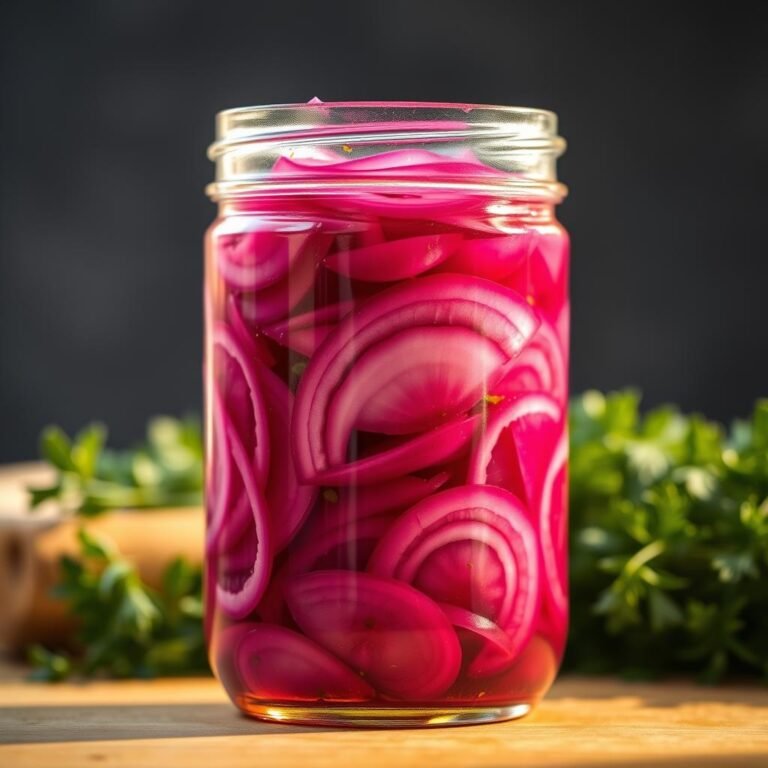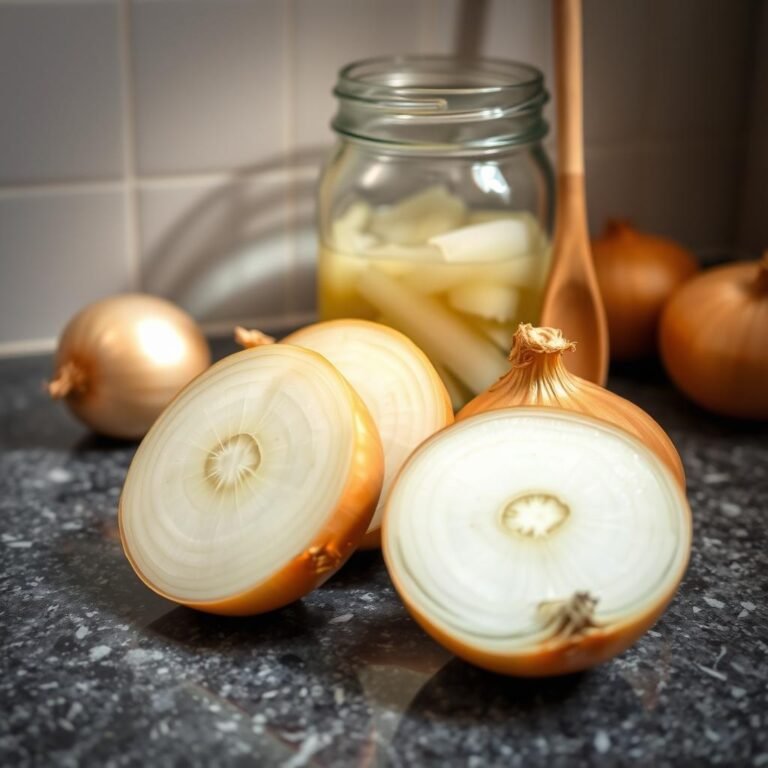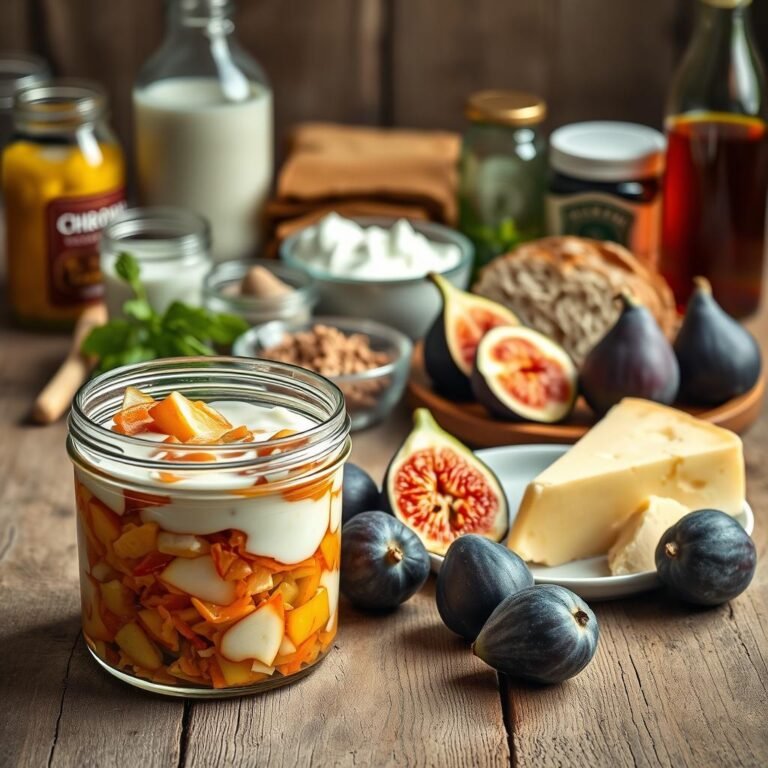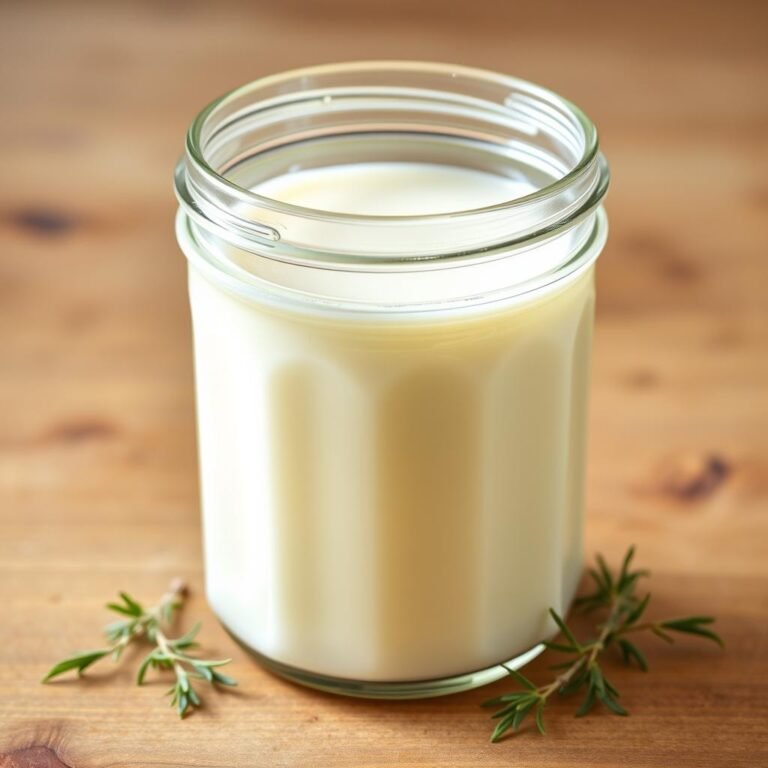How To Make Fermented Cabbage with Fermentation at Home

Making fermented cabbage, also known as sauerkraut, is easy and traditional. It uses lactic acid fermentation. This guide is perfect for beginners. It shows how to make sauerkraut at home with just cabbage and salt.
If you want to know how to make fermented cabbage, this recipe is for you. It guides you through each step. You’ll get a tangy, flavorful, and probiotic-rich product.
By fermenting cabbage at home, you learn a traditional method. It preserves nutrients and boosts flavors naturally. The lactobacilli on cabbage leaves help.
What is Fermented Cabbage?
Fermented cabbage, also known as sauerkraut, is finely cut cabbage. It goes through a process called fermentation by lactic acid bacteria. This turns the cabbage into lacto fermented cabbage.
The cabbage is put in a brine solution. This solution is made of salt and water. It helps the good bacteria grow. This makes the cabbage taste tangy and adds to its nutritional value.
Health Benefits of Fermented Cabbage
Eating fermented cabbage has many health benefits. It’s full of probiotics from the fermentation process. This helps keep your gut healthy.
It also makes vitamins like Vitamin C and K more available. This makes sauerkraut not only tasty but also full of nutrients.
This food is low in calories but high in fiber. It’s great for adding nutritious foods to your diet. Fermented cabbage also has anti-inflammatory properties. Eating it can help reduce body inflammation.
Essential Ingredients for Fermented Cabbage
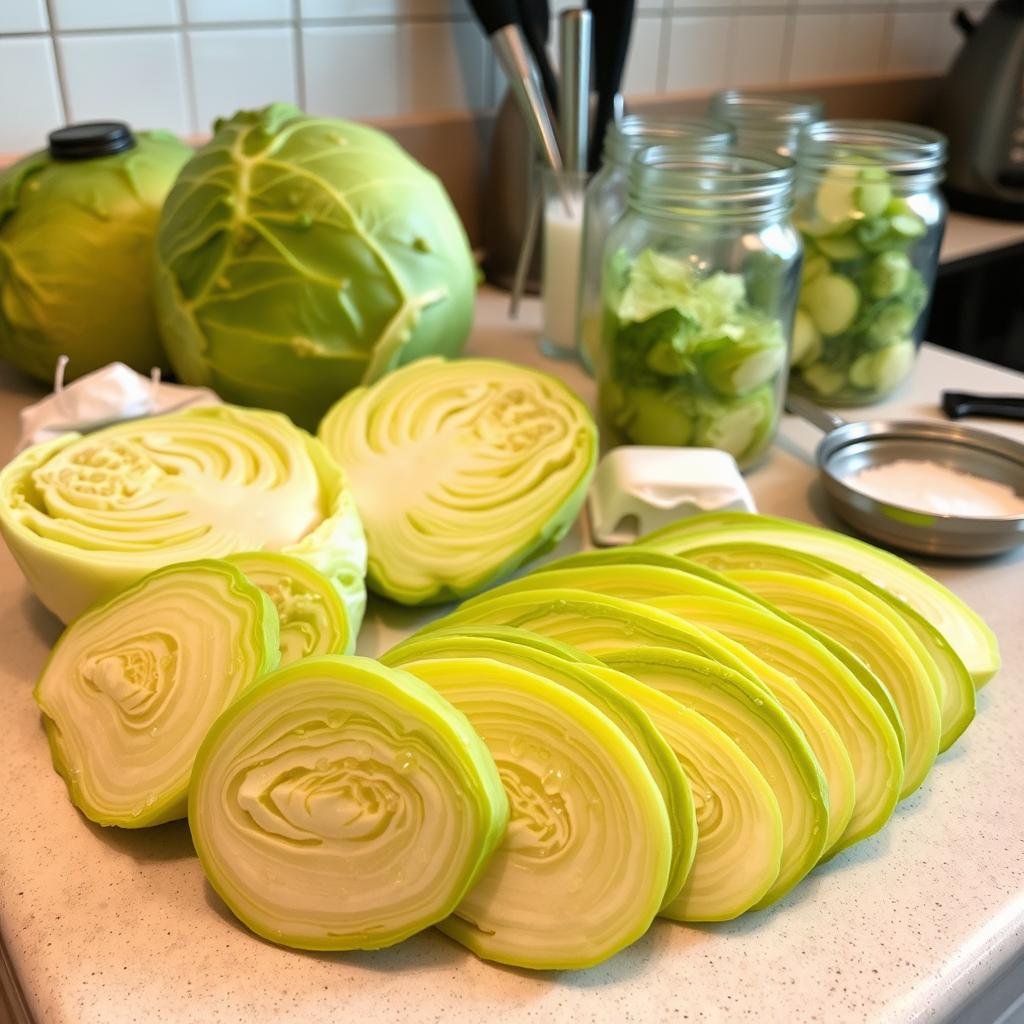
Learning how to make fermented cabbage starts with knowing the basic ingredients. These ingredients change the taste and how the cabbage ferments. Let’s look at what you need:
Choosing the Right Cabbage
Choosing the right cabbage is key for a great homemade sauerkraut. Green or purple cabbage works best. Green cabbage is most common because of its taste and texture after fermentation.
Make sure your cabbage is fresh, firm, and without blemishes. This will make your sauerkraut crisp and tasty.
Other Common Ingredients
Sea salt or fine kosher salt is also important for fermentation. Sea salt is best because it’s full of minerals and doesn’t have additives like iodine. A good rule is to use 1.5% to 2.5% of the cabbage’s weight in salt.
For example, 20 grams of salt for 1000 grams of cabbage is a good start.
You can also add caraway seeds or juniper berries for extra flavor. These ingredients aren’t necessary but they make your sauerkraut taste even better.
Tools Needed for Fermentation
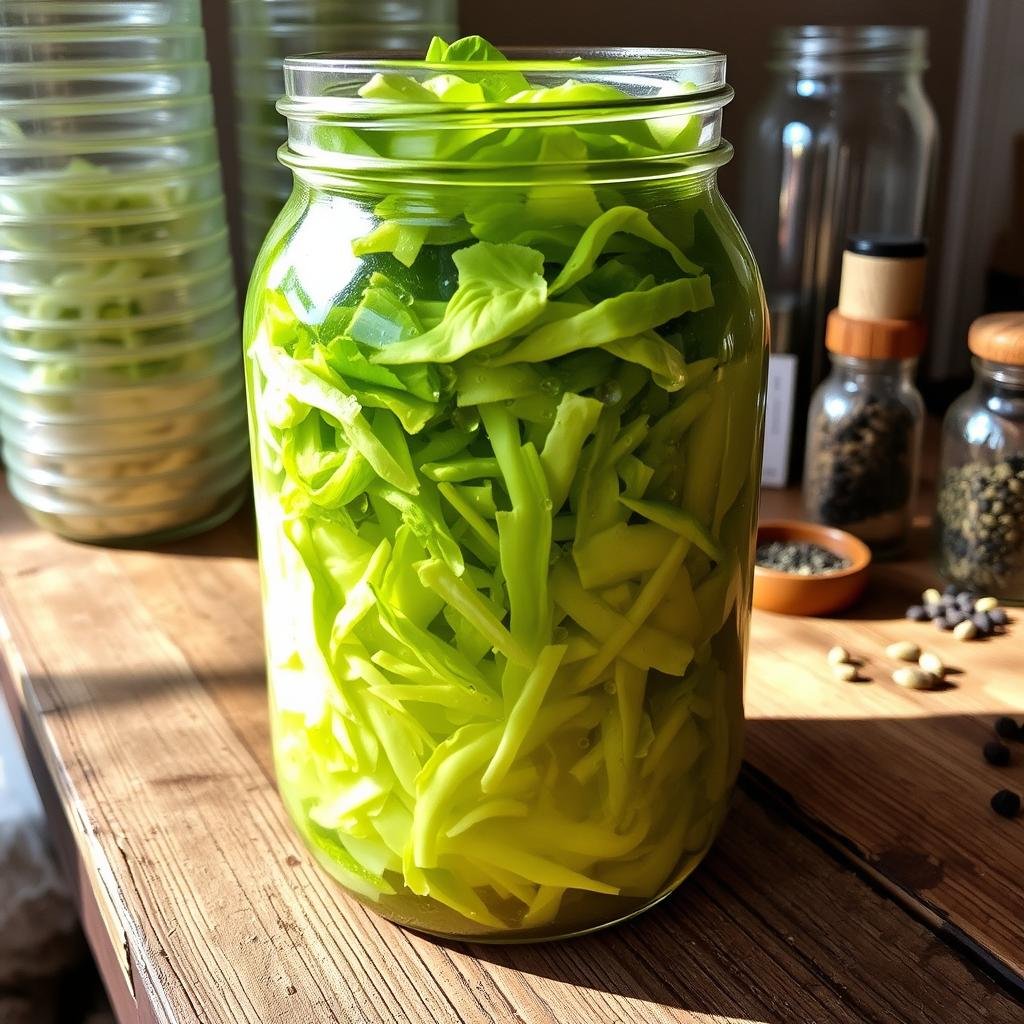
To ferment cabbage at home, you need the right tools. The right tools make your fermented cabbage better.
Containers for Fermentation
A good container is key for fermenting cabbage. Glass jars or ceramic crocks are best. They must be clean and tight to help the cabbage ferment well.
Optional Equipment
While you need a container, some tools can help more. Weights or a pressing plate keep the cabbage under liquid. This stops mold. A thermometer also helps keep the temperature right, between 60-75°F.
| Tool | Description | Importance |
|---|---|---|
| Glass Jar | Clear, airtight container for visible fermentation process. | Essential |
| Ceramic Crock | Traditional, sturdy container maintaining consistent conditions. | Essential |
| Weights/Pressing Plate | Ensures cabbage remains submerged under liquid. | Optional |
| Thermometer | Monitors and maintains the ideal temperature range. | Optional |
Step-by-Step Guide to Making Fermented Cabbage
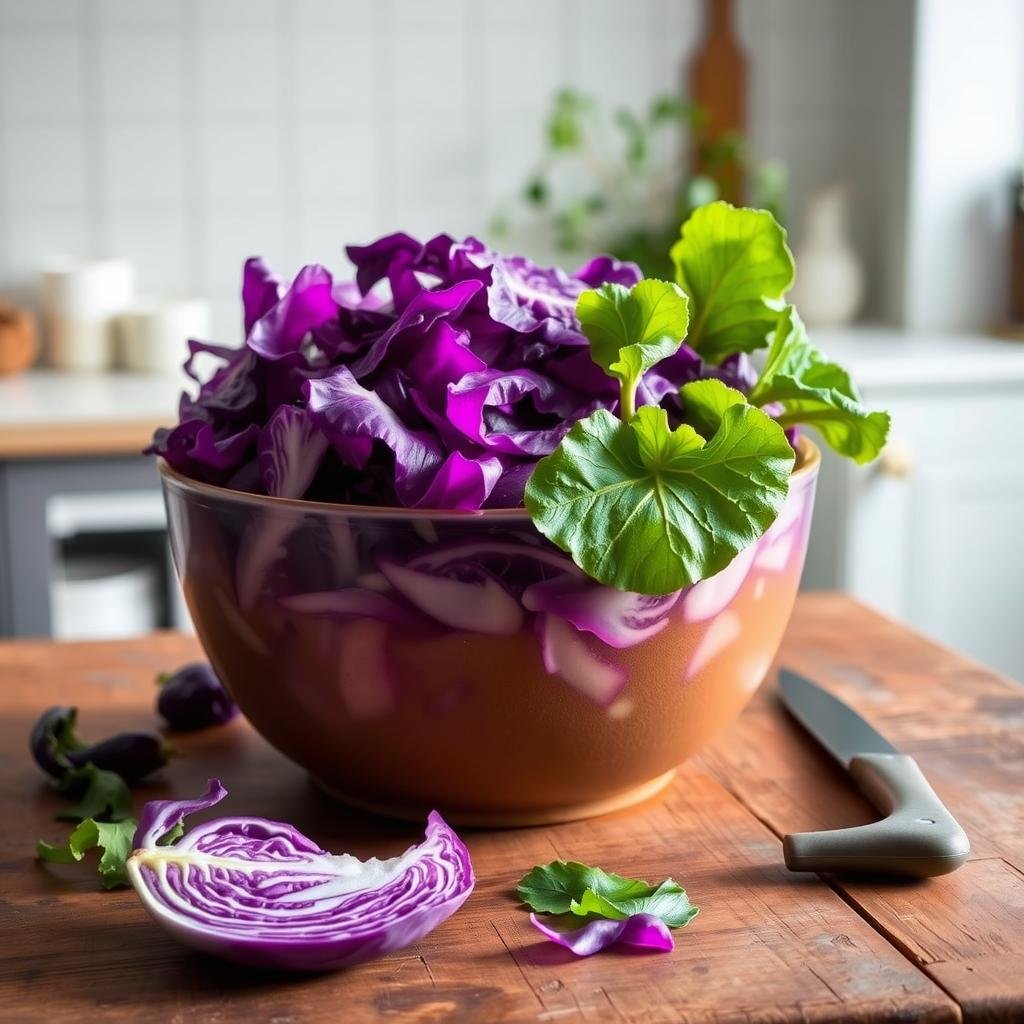
Making homemade sauerkraut is rewarding and easy. This guide will help you ferment cabbage successfully. You’ll get delicious results.
Preparing the Cabbage
First, take off the outer leaves of your cabbage. Cut the cabbage into thin shreds. This makes it ferment evenly.
Save some whole leaves to cover your cabbage later.
Salt Application Techniques
For your homemade sauerkraut recipe, use 1½ to 2 teaspoons of salt per pound of cabbage. For 2½ pounds, use 3¾ to 5 teaspoons of salt.
After tossing the cabbage with salt, rest it for 15 minutes. This helps release juices.
Packing the Cabbage into Containers
Massage the cabbage for about 5 minutes. This releases enough liquid for the brine. Pack the cabbage tightly into containers.
Make sure it’s fully covered by the brine. If not, use a 2% saltwater solution to cover it.
Fermentation Period and Conditions
Put your containers in a cool, dark place. Fermentation takes 10-14 days, but can last 1 to 4 weeks. Check your sauerkraut often.
Make sure it’s covered and taste it for readiness. The right conditions make your cabbage tangy and flavorful.
Understanding the Fermentation Process
Learning how to make fermented cabbage is a journey into the world of biochemistry. Fermentation changes sugars into gases, acids, or alcohol. For cabbage, lactobacilli on its surface turn sugars into lactic acid. This acid preserves the cabbage and gives it a sour taste.
How Fermentation Works
Fermentation breaks down carbs without oxygen. When making fermented cabbage at home, lactobacilli grow in the salty mix. They make lactic acid, which lowers the pH and keeps bad bacteria away. For more on fermentation, check out this guide.
Signs of Proper Fermentation
To know if your cabbage is fermented right, look for a few signs. A sour smell, like sauerkraut, is a big clue. The taste should get tangier, and the brine should look cloudy with bubbles.
Make sure to open the lid every day for five days to let gases out. Watching for these signs means your cabbage is fermented well. It’s safe and tastes great.
Flavor Variations for Fermented Cabbage
Adding new flavors to your homemade sauerkraut recipe makes it special. You can change the taste and get more nutrients. Traditional sauerkraut is just cabbage and salt. But, adding spices, herbs, and mix-ins can make it taste amazing.
Adding Spices and Herbs
- Caraway seeds: A classic addition that complements the tangy flavor of sauerkraut.
- Dill: Adds a fresh, herbaceous note.
- Garlic: Imparts a robust, savory flavor.
Creative Mix-Ins
Want to try something new? Creative mix-ins can turn your sauerkraut into a dish to remember.
- Shredded carrots: Add sweetness and a delightful crunch.
- Apples: Introduce a hint of natural sweetness.
- Beets: Give a vibrant color and earthy flavor to your lacto fermented cabbage.
Looking for more ideas? Try red cabbage, beet, and ginger. They’re great in egg salad and potatoes. Or, mix radish for a spicy taco topping. These flavors can please everyone and boost your sauerkraut’s nutrition.
Common Mistakes to Avoid
When learning how to make fermented cabbage, it’s important to avoid common mistakes. The right amount of salt and good hygiene are key. These steps help ensure your batch turns out well.
Over-Salting or Under-Salting
One big mistake is not getting the salt right. Too much salt can slow down fermentation. Too little might let bad bacteria grow, causing spoilage. To avoid this, weigh your veggies to get the salt just right.
Ignoring Hygiene Practices
Keeping everything clean is vital in making fermented cabbage. Make sure all tools and containers are spotless before use. This simple step can greatly improve your fermentation results.
| Common Mistake | Impact on Fermentation | Solution |
|---|---|---|
| Not weighing vegetables | Incorrect salt amounts | Use a kitchen scale to measure accurately |
| Insufficient liquid | Hinders fermentation | Add salted water or use a weight |
| Opening the jar | Introduces unwanted microorganisms | Keep the jar sealed during fermentation |
| Lack of proper equipment | Inconsistent results | Get appropriate containers and weights |
| Fear of starting | Missed opportunities | Take the plunge and start fermenting |
Storing Fermented Cabbage
Storing your fermented cabbage right is key. It keeps its taste, texture, and health benefits. Knowing how to store it well can make it last longer and stay safe.
Best Practices for Storage
Use airtight containers to keep air out. This stops spoilage. Make sure the sauerkraut stays under its brine to stop mold.
Refrigeration slows down fermentation. This helps keep the cabbage fresh for a longer time.
Shelf Life of Fermented Cabbage
Homemade sauerkraut can last about two months in the fridge. If you keep it submerged and cold, it can last even longer. Check it often for bad smells or color changes.
Troubleshooting Fermented Cabbage
Learning to make lacto-fermented cabbage means knowing how to fix problems. It’s key to get your cabbage to taste great and be safe. We’ll cover common issues like bad tastes and mold.
Addressing Off-Flavors
Bad tastes in cabbage can come from wrong temperatures or germs. If your cabbage tastes odd, check its storage. It should be between 65-72°F (18-22°C) for best flavor.
High or low temperatures can mess up the taste. Make sure your setup is clean and germ-free. Germs can also make cabbage taste bad.
Identifying Mold Issues
Mold on sauerkraut means it got air. Keep cabbage in brine to stop mold. Use tight containers to keep air out.
If mold shows up, take off the bad parts fast. A white, powdery stuff on top is usually okay yeast. But throw away cabbage with black, blue, or pink mold.

